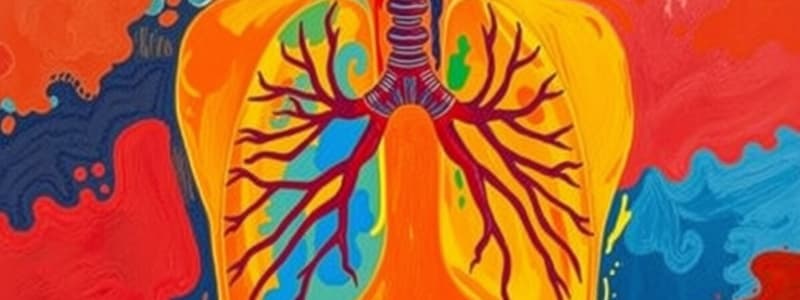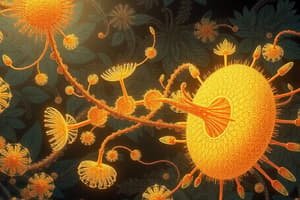Podcast
Questions and Answers
What material do cells release energy from during respiration?
What material do cells release energy from during respiration?
- ATP
- Oxygen
- Carbon Dioxide
- Glucose (correct)
What substance is energy from respiration stored in?
What substance is energy from respiration stored in?
ATP
Which type of respiration requires oxygen?
Which type of respiration requires oxygen?
- Anaerobic
- Aerobic (correct)
- Cellular
- Glycolysis
Where do most reactions of respiration occur in the cell?
Where do most reactions of respiration occur in the cell?
What are two other products of respiration besides energy?
What are two other products of respiration besides energy?
What type of respiration doesn't require oxygen?
What type of respiration doesn't require oxygen?
Match the stages of respiration with their descriptions:
Match the stages of respiration with their descriptions:
What happens to a glucose molecule in the cytoplasm?
What happens to a glucose molecule in the cytoplasm?
What is glucose turned into during glycolysis?
What is glucose turned into during glycolysis?
The end product of glycolysis is __________.
The end product of glycolysis is __________.
What is produced in the Krebs cycle?
What is produced in the Krebs cycle?
How many ATP are made in aerobic respiration?
How many ATP are made in aerobic respiration?
How many ATP are made in anaerobic respiration?
How many ATP are made in anaerobic respiration?
What does aerobic respiration need?
What does aerobic respiration need?
What is the respiration equation?
What is the respiration equation?
What chemical process produces ATP in mitochondria?
What chemical process produces ATP in mitochondria?
What carries not so high energy electrons?
What carries not so high energy electrons?
What helps electrons travel down the electron transport chain?
What helps electrons travel down the electron transport chain?
What is the end product of fermentation (anaerobic respiration)?
What is the end product of fermentation (anaerobic respiration)?
What is an energy storage molecule?
What is an energy storage molecule?
Where does the electron transport chain (ETC) occur?
Where does the electron transport chain (ETC) occur?
Flashcards are hidden until you start studying
Study Notes
Respiration Basics
- Glucose is the primary material for energy release during respiration.
- ATP (adenosine triphosphate) is the stored energy produced from respiration.
Types of Respiration
- Aerobic respiration requires oxygen and occurs in mitochondria.
- Anaerobic respiration occurs without oxygen, mainly in muscle cells.
Respiration Processes
- The first stage of respiration is glycolysis, occurring in the cytoplasm, where glucose is broken down into pyruvate.
- The second stage is the Krebs cycle (also known as citric acid cycle), producing FADH2, ATP, NADH, and CO2.
- The electron transport chain (ETC) is the third step, occurring in the mitochondria.
Energy Production
- Aerobic respiration produces 34-36 ATP molecules, while anaerobic respiration produces only 2 ATP molecules.
- As ATP is utilized in the body, it converts into ADP (adenosine diphosphate).
By-products of Respiration
- Aerobic respiration generates carbon dioxide and water as primary by-products, while anaerobic respiration produces lactate, ethanol, or ethyl alcohol.
Cellular Structures and Functions
- Most respiration reactions take place in mitochondria, which have folded membranes to accommodate the ETC's requirements.
- FADH2 transports lower energy electrons and oxygen aids their transfer down the ETC.
Chemical Equations
- The overall equation for cellular respiration is C6H12O6 + 6O2 → 6H2O + 6CO2 + ATP.
Energy and Metabolism
- ATP serves as the main energy storage molecule for cells, while metabolism describes how organisms acquire and use energy.
Additional Concepts
- The Calvin cycle requires ATP and NADPH but is separate from respiration.
- The end product of glycolysis is pyruvate, which is essential for subsequent respiration stages.
Studying That Suits You
Use AI to generate personalized quizzes and flashcards to suit your learning preferences.




